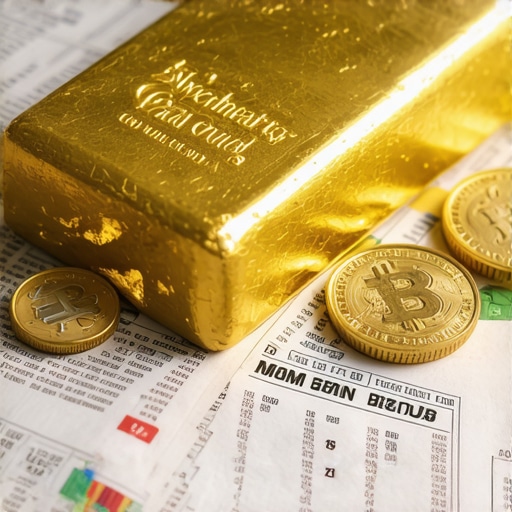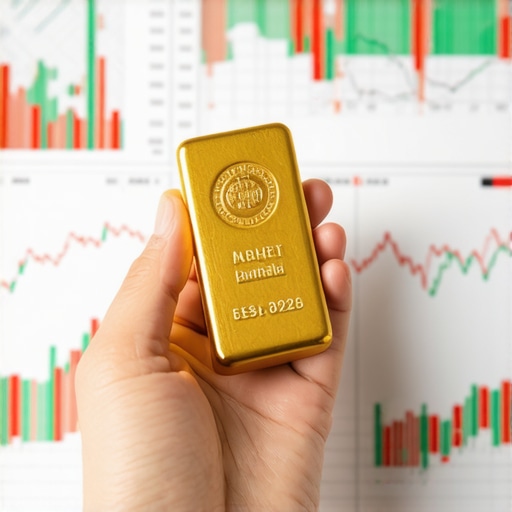How My Journey into Gold Investing Began
I still remember the first time I seriously considered investing in gold. It was during a period of economic uncertainty, and I felt the need to protect my savings from inflation and market volatility. Like many beginners, I was overwhelmed by the options—gold coins, bars, ETFs, mining stocks, and more. But over time, through trial, error, and research, I learned some essential tips that made my gold investment journey smoother and more rewarding.
The Personal Lessons I Learned About Investing in Gold
One key insight I discovered early on is that understanding the different forms of gold investments is crucial. Physical gold, such as bullion bars and coins, offers tangible security but requires safe storage and trusted dealers. On the other hand, gold ETFs and mutual funds provide easier liquidity and diversification but come with market risks. I found that balancing these can help tailor your portfolio to your risk tolerance and goals.
Moreover, I realized the importance of timing and market trend analysis. Keeping an eye on global economic indicators, central bank gold purchases, and geopolitical events helped me make more informed buying decisions. For beginners interested in learning how to analyze gold market trends, I recommend exploring resources like this guide that breaks down complex market signals into actionable insights.
What Are the Common Mistakes Beginners Should Avoid When Investing in Gold?
From my experience, one common pitfall is rushing into purchases without verifying the credibility of gold dealers. I’ve heard stories of counterfeit gold and inflated prices, so I always advise newcomers to research thoroughly and consider buying from reputable sources. You can check out trusted dealer recommendations in this helpful post.
Another mistake is neglecting the overall portfolio balance. I used to focus solely on physical gold, but diversifying with gold stocks and ETFs helped me mitigate risks and seize growth opportunities. For those curious about which gold investment types fit best, the article types of gold investments: bars, coins, and ETFs is a great starting point.
Why I Believe Gold Is a Smart Hedge Against Inflation and Economic Risks
Throughout my investing journey, gold has consistently served as a reliable hedge against inflation and economic downturns. When currencies weaken or stock markets fluctuate, gold’s intrinsic value often shines through. This is why many financial experts, including those cited by Investopedia, emphasize gold’s role in preserving wealth.
That said, I always remind myself and fellow beginners that gold investing isn’t a get-rich-quick scheme. It requires patience, continuous learning, and strategic planning. If you’re starting your own gold investing journey, I’d love to hear about your experiences or questions. Feel free to share your thoughts or stories in the comments below!
Navigating Gold Investment Complexities: Beyond the Basics
As my experience with gold investing deepened, I encountered more nuanced challenges and opportunities that beginners often overlook. For instance, the impact of geopolitical tensions on gold demand can be subtle but profound. Investors who track these events closely can anticipate price fluctuations more effectively. Additionally, understanding the subtle differences between gold mining stocks and ETFs is essential; mining stocks offer leveraged exposure to gold prices but carry operational risks, while ETFs provide diversified and liquid access to the metal itself.
How Can Investors Optimize Gold Portfolio Allocation Amid Market Volatility?
Portfolio allocation remains a cornerstone of successful gold investing, especially in volatile markets. One advanced strategy involves dynamically adjusting gold holdings based on inflation expectations and real interest rate trends. When real rates turn negative, gold typically outperforms as a non-yielding asset becomes more attractive. Conversely, during rising real rates, gold might underperform, prompting a temporary reduction in exposure. Incorporating a mix of physical gold, ETFs, and selective mining stocks can enhance both stability and growth potential.
For investors seeking comprehensive guidance on selecting gold mutual funds that align with stable growth objectives, resources like this expert guide provide invaluable insights into fund performance, expense ratios, and management quality.
Evaluating the Role of Central Banks in Shaping Gold Market Dynamics
One often underappreciated aspect is the strategic role central banks play in the gold market. Central bank gold purchases and sales can significantly influence gold prices and investor sentiment. In recent years, several major central banks have increased their reserves, signaling confidence in gold as a reserve asset amid global economic uncertainties. Monitoring central bank activity provides a macroeconomic perspective that can inform timing decisions and portfolio adjustments.
Understanding these institutional dynamics complements personal investing strategies and helps investors anticipate broader market trends. For a detailed analysis of this topic, you might explore how central bank gold purchases influence price movements.
What Are the Practical Implications of Gold’s Supply Chain Constraints for Investors?
Another crucial factor influencing gold’s investment profile is supply chain dynamics, including mining output, recycling rates, and geopolitical factors affecting production. Limited new gold supply combined with steady or rising demand can create upward price pressure over time. Investors should be aware of how mining disruptions or regulatory changes in gold-producing countries may impact the market.
As noted by the World Gold Council, understanding these supply-demand fundamentals is key to anticipating gold price trends and making informed investment decisions (World Gold Council – Gold Demand Trends).
If you found these insights helpful, consider sharing this post with fellow investors or leaving a comment about your own gold investment experiences and questions. For those ready to deepen their knowledge, exploring how to analyze gold market trends can be a great next step.
Reflecting on the Emotional Dynamics of Gold Investing
One aspect of gold investing that often goes unspoken is the emotional journey it entails. Beyond the charts, trends, and macroeconomic indicators, there’s a personal rhythm to how one experiences the market’s ups and downs. Early in my journey, I found that reacting impulsively to short-term price volatility often led to regret. Over time, cultivating patience and a steady mindset became as important as understanding physical gold versus ETFs or mining stocks.
It’s fascinating how gold, a timeless asset, can evoke such a wide spectrum of feelings – from security and optimism to anxiety during market dips. I believe that embracing this emotional complexity enhances an investor’s resilience and ultimately strengthens decision-making.
How Do You Balance Gold’s Role as a Safe Haven with Its Market Risks?
This question has become central in my evolving strategy. While gold is widely regarded as a hedge against inflation and economic turmoil, it’s not immune to price corrections or periods of underperformance. My experience taught me that integrating gold thoughtfully means recognizing when to lean more heavily on its stability and when to temper exposure due to rising real interest rates or shifts in investor sentiment.
One practical approach I adopted was to complement physical gold holdings with diversified gold ETFs and select mining stocks, as discussed in this analysis. This mix helped me capture growth potential while maintaining a buffer against volatility.
Moreover, I found that monitoring central bank activities adds a layer of strategic insight. Central banks’ gold reserve purchases often signal broader economic confidence or caution, impacting market momentum. For a deep dive on this topic, I recommend this detailed examination.
Why Understanding Global Supply Chain Nuances Changed My Perspective
Initially, I viewed gold simply as a commodity whose price rose and fell with demand. However, learning about the underlying supply chain – mining output constraints, geopolitical tensions in producing regions, and recycling trends – revealed a richer picture. These factors don’t just influence price; they affect timing and investment selection.
For example, when mining operations face disruptions or regulatory hurdles, supply tightens, creating upward pressure on prices. This awareness pushed me to consider not just the metal itself but also investing in top-performing mining stocks that can capitalize on these dynamics. The World Gold Council’s research (Gold Demand Trends) became an invaluable resource for tracking these shifts.
How Do You Navigate the Complexities of Portfolio Allocation with Gold in 2025?
With markets increasingly volatile, I’ve found portfolio allocation to be both an art and a science. A key insight is to regularly revisit your allocation percentages in response to inflation trends, global economic signals, and interest rate environments. In periods of negative real rates, increasing gold exposure can provide strong protection. Conversely, when real rates climb, temporarily reducing exposure can preserve capital for other opportunities.
In this context, combining physical gold, ETFs, and carefully chosen mining stocks creates a balanced approach. For those curious about structuring such portfolios, the guide on selecting gold mutual funds for stable growth offers excellent perspectives that complement personal investing strategies.
Throughout my journey, the evolving nature of gold investment continues to challenge and inspire me. I’d genuinely love to hear from you—whether you’re just starting out or refining your approach, your experiences and questions enrich this community. Feel free to share your stories or insights below!
Harnessing Advanced Market Signals for Tactical Gold Investment
Delving deeper into the gold investment landscape, I’ve come to appreciate the nuanced signals that sophisticated investors monitor to sharpen their edge. Beyond the conventional economic indicators, subtler cues such as shifts in gold forward curves, options market volatility, and sentiment indexes reveal underlying market psychology and potential inflection points. These indicators, when combined with macroeconomic data, enable a more tactical approach to adjusting portfolio exposure. For instance, observing contango or backwardation in gold futures can provide insights into near-term supply-demand imbalances, helping to time entries or exits more judiciously.
Integrating these complex signals requires discipline and a willingness to engage with diverse data streams. For readers eager to elevate their analysis, the resource how to analyze gold market trends for smarter investment moves offers a comprehensive framework that demystifies these advanced concepts.
How Can Emotional Resilience Enhance Decision-Making in High-Stakes Gold Trading?
One of the most profound revelations in my journey has been the critical role emotional resilience plays during turbulent market phases. Gold, often subject to swift swings triggered by geopolitical shocks or sudden central bank announcements, can test even seasoned investors’ composure. I found that cultivating mindfulness and detachment from short-term noise allowed me to stick to my strategic plans rather than capitulating to fear or greed.
This emotional discipline is not innate; it requires intentional practice and reflection. By keeping a trading journal and reviewing decisions through the lens of emotional triggers, I developed greater self-awareness, which in turn reinforced more rational, data-driven choices. This introspective approach transformed volatility from a source of anxiety into an opportunity for strategic advantage.
The Subtle Influence of Emerging Central Bank Gold Policies in 2025
Recently, central banks have adopted increasingly sophisticated approaches to gold reserve management, reflecting broader shifts in global economic paradigms. The move toward diversification away from traditional reserve currencies and into gold underscores its enduring role as a sanctuary asset amid geopolitical uncertainties and inflationary pressures. According to the latest analysis from the World Gold Council’s 2025 Gold Demand Trends report, central banks have accelerated their purchasing programs, especially in emerging economies, signaling a strategic pivot that could reshape gold’s supply-demand balance.
Understanding these evolving policies helps investors anticipate price momentum and align their portfolios accordingly. For those seeking to interpret central bank moves within their investment strategy, exploring how central bank gold purchases drive gold price movements offers an insightful deep dive.
If my reflections resonate with your investment journey or spark new questions, I warmly invite you to share your experiences or insights below. Engaging in this dialogue not only enriches our collective understanding but also cultivates a community grounded in shared expertise and growth.
Things I Wish I Knew Earlier (or You Might Find Surprising)
The Emotional Rollercoaster Is Real — But Manageable
One surprising aspect of gold investing that I didn’t fully grasp at first was how much my emotions could sway my decisions. Early on, I found myself reacting to every price dip or surge with anxiety or excitement, which rarely ended well. Over time, I learned that cultivating patience and emotional resilience is just as important as understanding market fundamentals. This helped me stay the course during volatile phases and avoid impulsive moves.
Physical Gold vs. Paper Assets: There’s No One-Size-Fits-All
I used to think physical gold was the safest and best option hands down. While it does provide tangible security, I realized diversifying with gold ETFs and mining stocks can offer better liquidity and growth opportunities. Balancing these different forms helped me tailor my portfolio to my risk tolerance and financial goals. For those starting out, exploring the differences between bars, coins, and ETFs is a great first step.
Timing Isn’t Everything, but It Matters More Than You Think
Gold is often viewed as a long-term hedge, but I found that paying attention to market trends and macroeconomic signals can improve the timing of buying and selling. Watching central bank gold purchases and inflation indicators gave me a clearer picture of when gold might outperform. If you want to dive deeper, this guide breaks down how to read those signals effectively.
Trusted Dealers Are Worth Their Weight in Gold
One hard lesson was learning to vet gold dealers carefully. Unfortunately, the market has its share of counterfeit risks and pricing pitfalls. I recommend newcomers check out reputable sources and guides like this trusted dealers list to avoid costly mistakes and ensure authenticity.
Supply Chain Dynamics Are More Than Just Background Noise
At first, I didn’t pay much attention to how gold mining output, geopolitical factors, and recycling rates influence prices. But understanding these supply-demand nuances helped me predict price pressures and identify investment opportunities, especially in mining stocks. The World Gold Council’s reports became a key resource for staying informed.
Resources I’ve Come to Trust Over Time
World Gold Council – Their research reports, like the Gold Demand Trends, offer comprehensive data and insights that helped me understand the broader market dynamics and supply-demand fundamentals.
BuyingGoldNow.com Guides – This site has been a goldmine (pun intended) for beginner-friendly yet detailed articles, such as how to analyze gold market trends and finding trusted gold dealers. Their clear explanations made complex topics accessible.
Investopedia – For foundational financial concepts and practical investing tips, their articles on gold investing helped me grasp the basics and beyond with credibility.
Central Bank Gold Purchase Analyses – Reports and articles like how central bank gold purchases influence price movements gave me a macro perspective that’s crucial for timing and portfolio strategy.
Parting Thoughts from My Perspective
Reflecting on my gold investing journey, I’d say the biggest takeaway is that gold is more than just a commodity or a safe haven—it’s a multifaceted asset that requires a blend of strategic thinking, emotional discipline, and continuous learning. The key is not to chase quick wins but to build a balanced, informed portfolio that integrates physical gold, ETFs, and mining stocks in ways that suit your personal goals and market conditions.
Understanding gold’s role as a hedge against inflation and economic risks, while also recognizing its market complexities, has shaped how I approach investing in this timeless metal. If you’re just starting out or looking to refine your strategy, take the time to explore trusted guides and stay curious about the evolving market signals.
If this resonated with you, I’d love to hear your thoughts or experiences. Feel free to share your story or questions in the comments below — let’s learn and grow together in this fascinating journey of gold investing.










